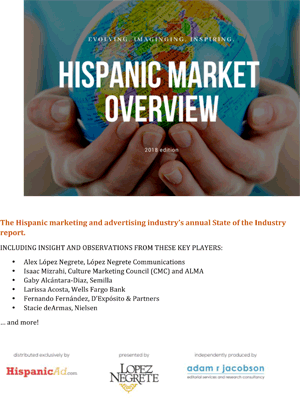![]() In the latest episode of “Behind the Numbers,” eMarketer analyst Lauren Fisher is joined in the studio by digital strategist Chris Lundquist for a conversation about consumers’ view of loyalty and what the major motivators are for building that loyalty.
In the latest episode of “Behind the Numbers,” eMarketer analyst Lauren Fisher is joined in the studio by digital strategist Chris Lundquist for a conversation about consumers’ view of loyalty and what the major motivators are for building that loyalty.
Marketing
What Truly Motivates Customer Loyalty? [PODCAST]
Brands need to balance short and long-term
![]() I was browsing the Kantar Media’s 2018 Dimensions report (well worth a read), when I came across a section on the need to strike a better balance between short and long-term. This seems to be a topic of increasing interest to marketers, but how do you find the right balance? by Nigel Hollis
I was browsing the Kantar Media’s 2018 Dimensions report (well worth a read), when I came across a section on the need to strike a better balance between short and long-term. This seems to be a topic of increasing interest to marketers, but how do you find the right balance? by Nigel Hollis
How to overcome five critical challenges of activating brand purpose
 By now, most marketers are aware of the importance of having a brand purpose — a clearly defined reason for a brand’s existence that goes beyond sales and profits, has a distinct societal benefit, and, at least in theory, provides a framework for every strategic business decision. Being purposeful has enabled brands like TOMS Shoes, Nike, Patagonia, Airbnb, and other leading brands to gain a market advantage — and oodles of positive buzz — in a business era defined by the collision of social media and social consciousness.
By now, most marketers are aware of the importance of having a brand purpose — a clearly defined reason for a brand’s existence that goes beyond sales and profits, has a distinct societal benefit, and, at least in theory, provides a framework for every strategic business decision. Being purposeful has enabled brands like TOMS Shoes, Nike, Patagonia, Airbnb, and other leading brands to gain a market advantage — and oodles of positive buzz — in a business era defined by the collision of social media and social consciousness.
Why DTCD (Direct-To-Consumer DATA) Is Secret To DTC Success
 Luma Partners’ Terry Kawaja had quite the provoking title for his presentation at the recent Association of National Advertisers’ Masters of Marketing Conference: “Fire Your CMO.”
Luma Partners’ Terry Kawaja had quite the provoking title for his presentation at the recent Association of National Advertisers’ Masters of Marketing Conference: “Fire Your CMO.”
How Media Consumption Varies Around the World [PODCAST]
![]() In the latest episode of “Behind the Numbers,” eMarketer’s Karin von Abrams and GlobalWebIndex’s chief research officer, Jason Mander, highlight key data from the new Global Media Intelligence report.
In the latest episode of “Behind the Numbers,” eMarketer’s Karin von Abrams and GlobalWebIndex’s chief research officer, Jason Mander, highlight key data from the new Global Media Intelligence report.
Media Buying
 Increasingly, brands are opting to buy digital media through programmatic means, and the sharp uptick in adoption of this model is causing disruption among brands and agencies alike.
Increasingly, brands are opting to buy digital media through programmatic means, and the sharp uptick in adoption of this model is causing disruption among brands and agencies alike.
Hispanic Market Overview 2018 [REPORT] – DOWNLOAD for FREE
 HispanicAd.com in association with Adam R Jacobson are proud to announce the availability of the 2018 Hispanic Market Overview.
HispanicAd.com in association with Adam R Jacobson are proud to announce the availability of the 2018 Hispanic Market Overview.
To download click on image or CLICK HERE.
Univision Creator Network Signs Latina Beauty Creator KathleenLights
 Univision Creator Network (UCN) announced the signing of YouTube beauty creator Kathleen Fuentes, KathleenLights.
Univision Creator Network (UCN) announced the signing of YouTube beauty creator Kathleen Fuentes, KathleenLights.
The CMO Perspective on Trust, Quality, and Brand Safety in Advertising
 The CMO position is easily one of the most scrutinized roles in the C-suite. Often tasked with building a memorable brand, managing the company’s reputation, and deploying marketing strategies that tie back to measurable success, CMOs have a lot of responsibility. Jessica Rodriguez, president and COO, Univision Networks and Univision CMO, recently joined an Advertising Week panel that covered the current state of trust in advertising. By A.Z. Porte
The CMO position is easily one of the most scrutinized roles in the C-suite. Often tasked with building a memorable brand, managing the company’s reputation, and deploying marketing strategies that tie back to measurable success, CMOs have a lot of responsibility. Jessica Rodriguez, president and COO, Univision Networks and Univision CMO, recently joined an Advertising Week panel that covered the current state of trust in advertising. By A.Z. Porte
BrandZ Top US Brands [REPORT]
 As consumers engage with brands in more and more places, customer experience is now just as important as perceptions of innovation for growing your brand. Those brands delivering on and exceeding consumer’s expectations have grown their brand value 200% more than those that haven’t!
As consumers engage with brands in more and more places, customer experience is now just as important as perceptions of innovation for growing your brand. Those brands delivering on and exceeding consumer’s expectations have grown their brand value 200% more than those that haven’t!
DOJ Clears Holding Companies In Commercial Practices Probe
 The Department of Justice has informed five ad holding companies that it is no longer investigating any of their subsidiaries as part of a probe into commercial production practices and possible bid-rigging that began in 2016.
The Department of Justice has informed five ad holding companies that it is no longer investigating any of their subsidiaries as part of a probe into commercial production practices and possible bid-rigging that began in 2016.
ANA Launches Center For Brand Purpose
 The ANA (Association of National Advertisers) announced the launch of a new initiative designed to fuel business growth by helping marketers create purpose-driven, strategic programs and solutions for their products and services.
The ANA (Association of National Advertisers) announced the launch of a new initiative designed to fuel business growth by helping marketers create purpose-driven, strategic programs and solutions for their products and services.
Protecting Customer Data Is a Top Challenge for CMOs
![]() Last week, HSBC Bank confirmed that someone hacked its customer data. These kinds of incidents continue to frequently pop up in the news and are emblematic of what stresses CMOs in a data-driven world.
Last week, HSBC Bank confirmed that someone hacked its customer data. These kinds of incidents continue to frequently pop up in the news and are emblematic of what stresses CMOs in a data-driven world.
Media Buying 2018 — Transparency at a Crossroads [REPORT]
 The transparency debate and distrust between advertisers and media buying agencies has been a topic in C-suites since Jon Mandel’s 2015 speech at the Association of National Advertisers’ (ANA) annual media conference, yet ANA’s work on transparency dates back to at least 2011. Interest took a new, unprecedented turn on October 10, 2018 when the ANA notified its members that the U.S. Federal Bureau of Investigation (FBI) asked the ANA to inform its members about the investigation and to ask its members to consider cooperating with the FBI investigation if they believed they might have been defrauded by their agencies.
The transparency debate and distrust between advertisers and media buying agencies has been a topic in C-suites since Jon Mandel’s 2015 speech at the Association of National Advertisers’ (ANA) annual media conference, yet ANA’s work on transparency dates back to at least 2011. Interest took a new, unprecedented turn on October 10, 2018 when the ANA notified its members that the U.S. Federal Bureau of Investigation (FBI) asked the ANA to inform its members about the investigation and to ask its members to consider cooperating with the FBI investigation if they believed they might have been defrauded by their agencies.
Filling the Data Consultancy Vacuum
 The advertiser community needs help dealing with the vast quantities of data generated not only from third parties (like social media platforms and the audience measurement organizations) but also from their own first-party data-sets. It’s one reason why advertisers are increasingly taking what used to be perceived as media agency tasks in-house.
The advertiser community needs help dealing with the vast quantities of data generated not only from third parties (like social media platforms and the audience measurement organizations) but also from their own first-party data-sets. It’s one reason why advertisers are increasingly taking what used to be perceived as media agency tasks in-house.
The case for change is made. Marketers changing is what matters.
 ANA celebrates 20 Years of Multicultural and Diversity Conferences
ANA celebrates 20 Years of Multicultural and Diversity Conferences
When P&G makes it known that this iconic house of brands stands for both Profits & Growth and Purpose & Good, marketers pay attention. It’s no surprise that this quote by P&G CMO Marc Pritchard is being retweeted, reposted and restated as a validating proof point in support of an industry discipline that has been given short shrift: “If you’re not doing multicultural marketing, you’re not doing marketing.” By Rochelle Newman-Carrasco – EVP, Hispanic Strategy Walton Isaacson
How Much Digital Advertising Is Too Much?
 It’s been almost two years since Marc Pritchard, Chief Brand Officer of Procter & Gamble, told the digital advertising industry to clean up its act. The e, currently the world’s second largest CPG company, was tired of what he perceived as massive waste in the digital advertising supply chain. He was referring to the lack of transparency between advertisers and digital agencies and the alphabet soup of ad-tech players that created complexity without always clearly defining value.
It’s been almost two years since Marc Pritchard, Chief Brand Officer of Procter & Gamble, told the digital advertising industry to clean up its act. The e, currently the world’s second largest CPG company, was tired of what he perceived as massive waste in the digital advertising supply chain. He was referring to the lack of transparency between advertisers and digital agencies and the alphabet soup of ad-tech players that created complexity without always clearly defining value.
The Case For Change [REPORT]
 Alliance for Inclusive & Multicultural Marketing (AIMM) has already begun to transform into a more inclusive, diverse,and proactive platform. Download the recently released study “Case for Change: Multicultural and Inclusive Marketing” as a Business Imperative for Long-Term Growth to help marketers better understand the importance of prioritizing multicultural and inclusive consumers in order to maximize overall corporate growth. Discover how to implement AIMM’s five point plan into your company’s overall marketing plan.
Alliance for Inclusive & Multicultural Marketing (AIMM) has already begun to transform into a more inclusive, diverse,and proactive platform. Download the recently released study “Case for Change: Multicultural and Inclusive Marketing” as a Business Imperative for Long-Term Growth to help marketers better understand the importance of prioritizing multicultural and inclusive consumers in order to maximize overall corporate growth. Discover how to implement AIMM’s five point plan into your company’s overall marketing plan.
2018 State of Hispanic-American Consumer [REPORT]
 The Hispanic population in the U.S. continues to grow, especially among the younger cohorts. Over one-quarter of kids 6-11 are Hispanic, with 24% in the 12- 17 and 18-34 cohorts. Hispanics make up 17.6% of the total 6+ population in the United States.
The Hispanic population in the U.S. continues to grow, especially among the younger cohorts. Over one-quarter of kids 6-11 are Hispanic, with 24% in the 12- 17 and 18-34 cohorts. Hispanics make up 17.6% of the total 6+ population in the United States.
The Marketing Diet
 How do we go about adopting healthy client/agency practices and relations to get budget fit? Once you get there, how do you stay budget fit? Let’s explore best practices to make this a successful, sustainable process.
How do we go about adopting healthy client/agency practices and relations to get budget fit? Once you get there, how do you stay budget fit? Let’s explore best practices to make this a successful, sustainable process.



























